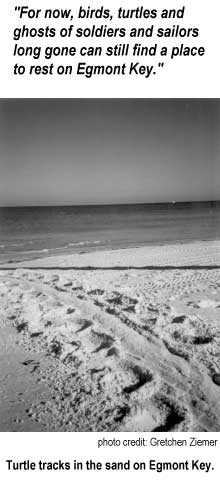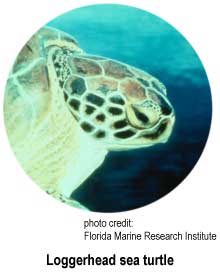By Mary Kelley Hoppe
 To the surprise of some and the delight of virtually all, sand placed at the northwest corner of Egmont Key two years ago not only is stalling erosion of the historic barrier island, it’s also proving quite popular with wildlife. Nesting birds and sea turtles flocked to the new beach this summer, despite concerns that the manmade area might not appeal to shore-nesters. The new beach, more than a quarter-mile long, was created with approximately 300,000 cubic yards of sand dredged from St. Petersburg’s Bayboro Harbor. In late June, Egmont Key Alliance members counted more than 100 chicks: 52 black skimmers, 38 least terns, 10 royal terns and two American oystercatchers – and nearly three times that many adult birds – all in the area of new sand placement near Battery Guy Howard. While only a fraction of the more than 4,000 chicks hatched on the protected wildlife sanctuary on the island’s southern end, it’s significant nonetheless. “Egmont is a microcosm of Tampa Bay,” says alliance member Sandy Colbert. “If wildife can adapt to new environments here, it’s a hopeful sign for the larger region.”Even more surprising, observers say, was sea turtle activity. Of 30 sea turtle nests on the island, seven were deposited on the new sand – despite predictions that the turtles would shun the manmade beach in favor of familiar grounds. As of Labor Day, there were 17 successful hatchings, including four in the new area. Reports also indicate 38 “false crawls” – in which a female approaches the beach and decides, for whatever reason, that it is not the right place or time. Those numbers represent an improvement over last year.
To the surprise of some and the delight of virtually all, sand placed at the northwest corner of Egmont Key two years ago not only is stalling erosion of the historic barrier island, it’s also proving quite popular with wildlife. Nesting birds and sea turtles flocked to the new beach this summer, despite concerns that the manmade area might not appeal to shore-nesters. The new beach, more than a quarter-mile long, was created with approximately 300,000 cubic yards of sand dredged from St. Petersburg’s Bayboro Harbor. In late June, Egmont Key Alliance members counted more than 100 chicks: 52 black skimmers, 38 least terns, 10 royal terns and two American oystercatchers – and nearly three times that many adult birds – all in the area of new sand placement near Battery Guy Howard. While only a fraction of the more than 4,000 chicks hatched on the protected wildlife sanctuary on the island’s southern end, it’s significant nonetheless. “Egmont is a microcosm of Tampa Bay,” says alliance member Sandy Colbert. “If wildife can adapt to new environments here, it’s a hopeful sign for the larger region.”Even more surprising, observers say, was sea turtle activity. Of 30 sea turtle nests on the island, seven were deposited on the new sand – despite predictions that the turtles would shun the manmade beach in favor of familiar grounds. As of Labor Day, there were 17 successful hatchings, including four in the new area. Reports also indicate 38 “false crawls” – in which a female approaches the beach and decides, for whatever reason, that it is not the right place or time. Those numbers represent an improvement over last year.
 By comparison, a record-setting 170 sea turtles nested on the area’s gulf beaches this year, according to Glenn Harmon of the Clearwater Marine Aquarium, whose counts include Caledesi Island south to Treasure Island.
By comparison, a record-setting 170 sea turtles nested on the area’s gulf beaches this year, according to Glenn Harmon of the Clearwater Marine Aquarium, whose counts include Caledesi Island south to Treasure Island.
While Egmont may be a bit player on the larger nesting stage, it’s noteworthy in a couple of respects: there’s no artificial lighting on the island to disorient the turtles and few natural predators.
The new beach also buys a bit more time for the battered island in its ongoing battle with the sea, which already has swallowed up three of five century-old artillery batteries. The island is only about half as wide as it was in the 1960s – a period of intense dredging and filling in Tampa Bay – and erosion has intensified since the 1980s. “We would have lost the last two (batteries) if this project hadn’t come together when it did,” says Richard Johnson, alliance president.
Johnson is quick to differentiate this from beach renourishment, where taxpayers typically foot the bill to construct or enlarge beachfront. Egmont instead took advantage of material the Army Corps of Engineers needed to discard. Dredged material is costly to truck away, even more expensive to haul out into the gulf – and the bay is quickly running out of storage room.
The Agency on Bay Management and the Corps both view Egmont Key as suitable for beach-quality dredged material from bay dredging projects, but an initial Corps survey to determine if beach stabilization would be cost-effective is unlikely to favor additional efforts. The next step would be a Congressionally funded reconnaissance study, which the alliance will vigorously pursue, of the factors and causes behind the island’s erosion and how to prevent it.
“If nature has decided to work against the island by sea level rise and gulf subsidence, then we may have to resign ourselves to that eventuality,” says Colbert. “However, if man is found to be at fault, then we may well be able to pursue manmade solutions. For now, birds, turtles and ghosts of soldiers and sailors long gone can still find a place to rest on Egmont Key.”
A HISTORY OF EGMONT KEY
EARLY 1500s Panfilo de Navarez and Hernando de Soto are thought to be among first European explorers to spot Egmont.1757 Tampa Bay and Egmont Key charted by Francisco Maria Celi, pilot of the Royal Spanish fleet.1763 Island named after John Perceval, 2nd Earl of Egmont, Irish House of Commons.1848 First lighthouse constructed, then damaged by hurricane.
1849 Egmont surveyed by Col. Robert E. Lee, who noted its strategic value as rationale for fortification.
1858 Lighthouse reconstructed “to withstand any storm.” New structure is 81 feet tall with a kerosene lamp and fixed Fresnel lens.
1859 Steamer Gray Cloud removes the last of the Seminoles who had been held at Egmont Key.
1861 Civil War begins. The lighthouse keeper removes Fresnel lens and equipment for safekeeping in Tampa. Union troops use Egmont as operations base for Gulf Coast blockades of the Confederacy.
1866 Civil War ends, lighthouse relit. Lighthouse keeper, assistant and families are primary residents until 1898.
1887 Quarantine station established during yellow fever epidemic.
1898 Construction begins on Fort Dade at outbreak of Spanish-American War; temporary gun batteries constructed to defend Tampa. Spanish fleet never comes, but fort construction continues. Build-out results in five coastal artillery batteries, remote-controlled undersea mines, and a town of 300 with electricity, telephones, a movie theater, bowling alley and tennis court. Quarantine station reestablished for troops returning from the Spanish-American War in Cuba.
1921 Fort Dade deactivated.
1928 Tampa Bay Pilots (est. 1886) set up operations on the island after Hillsborough County purchases and leases land to group.
1939 Lighthouse service transferred to U.S. Coast Guard.
1944 Lighthouse tower shortened, electric light installed, range increased to 22 miles.
1974 Egmont Key designated a National Wildlife Refuge.
1989 U. S. Fish and Wildlife Service and the Florida Park Service sign agreement to co-manage island. Egmont Key Alliance established.
Originally published Fall 2002